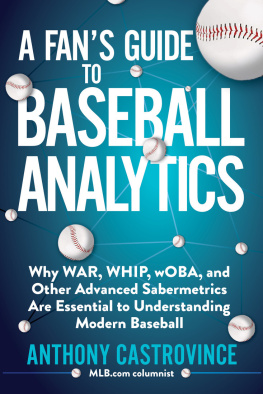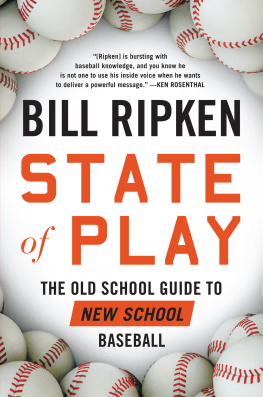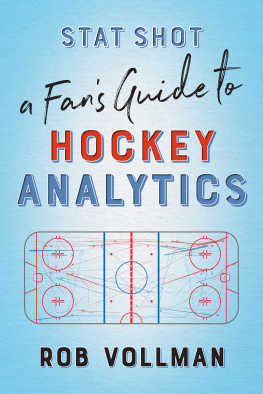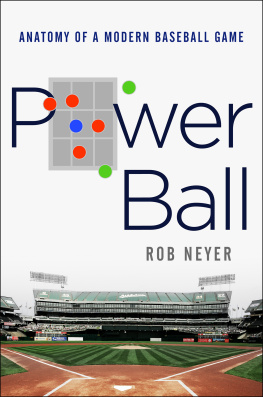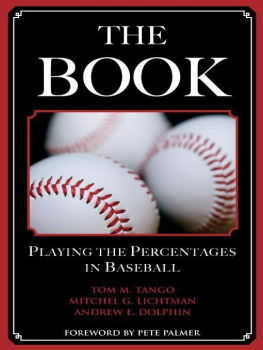


Copyright 2020 by Anthony Castrovince
All rights reserved. No part of this book may be reproduced in any manner without the express written consent of the publisher, except in the case of brief excerpts in critical reviews or articles. All inquiries should be addressed to Sports Publishing, 307 West 36th Street, 11th Floor, New York, NY 10018.
Sports Publishing books may be purchased in bulk at special discounts for sales promotion, corporate gifts, fund-raising, or educational purposes. Special editions can also be created to specifications. For details, contact the Special Sales Department, Sports Publishing, 307 West 36th Street, 11th Floor, New York, NY 10018 or .
Sports Publishing is a registered trademark of Skyhorse Publishing, Inc., a Delaware corporation.
Visit our website at www.sportspubbooks.com.
10 9 8 7 6 5 4 3 2 1
Library of Congress Cataloging-in-Publication Data is available on file.
Chart on courtesy of FanGraphs
The following tables, which appear in both the running text and appendix, are courtesy of FanGraphs: OBP, OPS, ISO, wOBA, BsR, wRC+, OPS+, ERA+, WHIP, GSc, FIP, FB%/LD%/GB%/IFFB%, K%/BB%, K/BB HR/FB, LOB%, IRS%, DRS/UZR, Inside Edge, DER, and WPA
Cover design by 5mediadesign
Print ISBN: 978-1-68358-344-8
Ebook ISBN: 978-1-68358-345-5
Printed in the United States of America
For my girlsKate, Ella, and Lilywho give me incalculable joy.
And for my Dad, who is fond of saying Statistics are for losers, but has promised to read this book anyway.
Table of Contents
Introduction
Stats What Im Talking AboutWhy Baseballs Nerdy Numbers Are Worth Learning
The nerds are ruining baseball!
Right away, I knew this emailed response to an article I had written for
An article based solely on advanced metrics is nauseating, the writer of this maddened missive continued. Most people dont know what any of those numbers mean, including me, and Ive been a CPA and financial analyst.
Two thoughts crossed my mind when I received this email:
Does the use of the past tense of Ive been mean this gentleman is retired from CPA and financial analyst work, or did he become so disenchanted with advanced mathematical concepts that he decided to leave the profession ahead of schedule?
When did I become a nerd? How did this happen?
We are all capable of myopic and mistaken perceptions of self, of not comprehending how our words, actions, or presence is observed by others. And right then, reading that email from that retired-or-embittered former CPA and financial analyst, it hit me: despite a general childhood aversion to math and an earnest intent on becoming a storyteller and not a statistician, I had, indeed, inadvertently wandered into and purchased property in the Valley of Nerdom!
This was not the path I set for myself in high school, where quite literally my only lasting memory from Algebra II class was arriving early on an exam day, prior to any other students or the teacher, and set the alarm on the clock radio (a makeshift replacement for the broken clock on the wall) to go off about 20 minutes before the end of the period. My classmates and I were mid-quiz, preoccupied with polynomials, when, to my delight and surprise, the alarm that I thought I had set to BUZZER turned out to be tuned to RADIO. Instead of a bothersome beep, something even better blared...
LOVE SHACK! wailed the buoyant voices of the B-52s. BABY, LOVE SHACK!
Ah, I had been blessed by the gods of algebraic intervention to have landed not just on our local pop station, Q104, and not just on the B-52s irresistible signature single, but on that millisecond of muteness in the song between Cindy Wilson yelling, Tin roof... rusted! and the drum kicking in the final chorus. This amalgam of a broken clock, a rousing radio, and a new wave band breaking the silence with its silly song was as close to a perfect achievement as I could ever hope to attain in this warped world.
Seriously, though, thats all I retained from math class.
Sports writing was, in my ardent estimation, the only fulfilling option on the career menua means of satiating my curiosity about the human condition, appeasing my attraction to the script-proof and aesthetic drama of athletic events, and distributing that little dose of dopamine which comes with a fun turn of phrase within a Microsoft Word document. I wanted to retell results with such forcefulness, such sentiment, such captivating eloquence that even those who attended or otherwise witnessed the event in question would gain new perspective on the proceedings.
If that meant tossing in a few field-goal percentages or left-on-base counts, so be it.
It just so happens that MLB.com had an internship available for a cub reporter who saw dugout access, internet bandwidth, and a $7-an-hour paycheck as a Godfather offer. Thus began a long love affair with the unusual-but-unmistakable rhythms of the baseball beat. The late nights and crazy flights. The colorful characters. The indecipherable-to-outsiders lingo. When you cover a sport that consumes the calendar with a series of tomorrowsone that offers its inhabitants the chance to repeat past fortunes or repair past flaws, all while humbling even the most blessed of the bunchit can teach you a lot about life itself.
But while this wasnt what youd call a Chevy Chaseesque, It was my understanding there would be no math scenario (baseball, after all, is the most numbers-driven competition this side of a grade school Mathlathon), I never anticipated that the game would become so consumed by an avalanche of analytics, above and beyond the back-of-the-baseball-card stuff I was more readily familiar and comfortable with. In my time around the game, front offices have been taken over by the disrupters, the data scientists, the men and women whowere it not for that aforementioned allure of performance art unfolding on fresh-cut grass and dirt diamondswould be splitting atoms or launching rockets. Not taking the time to understand the mathematical rationale behind their moves would have been journalistic malpractice on my part.
And while I was trying to make sense of this sport by counting on my fingers, some truly intelligent scribespeople who would probably bring as much value to a front office as they do to a front pagewere writing articles that challenged my preconceived notions, opened my eyes to concepts I had never considered, and just generally ran laps around anything analytical I could attempt to offer an audience. It didnt mean I couldnt still wax poetic and post pieces that capture the soulnot the statsof the sport. But I would be selling myselfand my readersshort if I didnt take the time to figure out what WAR, WHIP, wOBA, and the like mean and how they relate to player performance, instead of just making lame jokes about how silly they sound.
So yeah, maybe I did become a bit of a nerd. Or more accurately, I learned to appreciate and even enjoy what the actual nerdsthe folks whose true love of this great game compelled them to craft ways of contextualizing ithave to offer.
Yet where I whiffed in that aforementioned MVP piece (and, Im sure, many others) was in citing stats such as Christian Yelichs fWAR, Nolan Arenados wRC+, or Paul Goldschmidts OPS+ without properly, even if briefly, explaining what they mean to the readers who might not be familiar with them. Even stats like on-base percentage and slugging percentage, which have been around for decades and are considered rudimentary for some, are not fully grasped by others. Heck, Atlanta Braves manager Brian Snitker told me in 2019 that he still likes to write his players batting averages (alongside various matchup data) on his lineup cards before games, just because of the familiarity factor.
Next page
